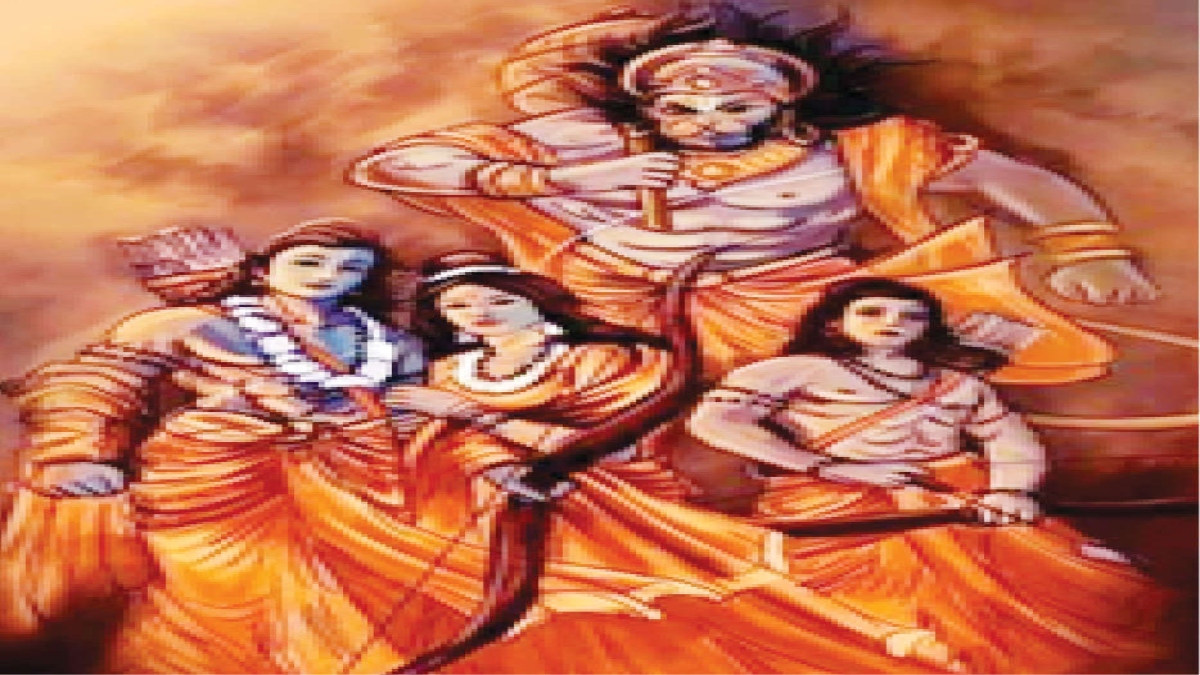
On attaining self-realisation, the first question that arises in the awakened one is, “How do I translate knowledge into action? How to manifest this knowledge? “One brings fruition to one’s realisation through service and a selfless attitude. The action that is born out of awakening is personified in Hanuman. Pure knowledge in action with total dedication is the essence of Hanuman.
Hanuman represents the mind, which has become the perfect servant of the self- that is symbolised by Ram. Our mind is likened to a monkey running around. That is why Hanuman is symbolically portrayed as a monkey. The restless mind is the one running after the sensory pleasures. When the mind has become still, it is Hanuman. Hanuman is the annihilation of worldly desires. As the mind becomes still, it associates with the atman i.e. Ram, and immense wisdom arises.
In his childhood, Hanuman is said to have playfully leapt into the sky and hidden the sun under his armpit, causing the world to fall into darkness. A still mind is beyond light and darkness; the outer world is ignorance, symbolised by darkness. The complete creation has dissolved, and pure nothingness remains. This incident represents the initial awakening in self-realisation, after which the awakened one continues to mature their realisation playing in the world as before, symbolised by Hanuman subsequently releasing the sun.
Hanuman appears only when Sita has been abducted by Ravan after becoming tempted by the golden deer, symbolising worldly pleasures. Hanuman is wisdom personified. He is said to have a deeper realisation of the self than even Ram but he is still Ram’s loyal servant. Wisdom makes one humble and the wise one serves selflessly.
A pure mind can leap into the world and bring about immense destruction to the organised way that worldly people lead their lives-they find their worldly affairs cease to be meaningful and important once they come into contact with a realised soul. This symbolic leap is taken by Hanuman to get to Lanka—the World of Man.
The realised person’s mind can only remain pure when it is with the self. This is symbolised as faithfulness and loyalty in Hanuman to Ram. The moment a fully realised mind comes into contact with the world, it recognises its illusory nature and burns it up with purified awareness. That is what happens when Hanuman enters Lanka, symbolic of the worldly basal pleasures.
Hanuman carries a ring given by Ram to show to Sita when he meets her, to prove to her that he is Ram’s authentic messenger. A self-realised person is no different looking from the men of the world. How then, to recognise someone who is a real messenger of God, a prophet, a messiah? What, then, is the mark of the enlightened?
The ring implies a circle of enclosed emptiness. The mark of self-realisation is that there is nothing inside, just emptiness, enclosed by an outer covering of the body. This nothingness permeates everything it contacts in the material world. This “silence of the void” can be experienced in the presence of realised beings. In return, signifying that she has realised this truth, Sita gives a bangle—another circle, to Hanuman, for Ram.
True service is to spearhead the fight to wean ourselves away from worldly pleasures and to be aligned with the self. This is implied by the great battle between Ram and Ravan to bring back Sita (who symbolises the body suffering the consequences of worldly karmas) in the grip of Ravan (who represents the hedonistic ego steeped in worldly pleasures, though skilful and adept in worldly affairs and indulgences).
Ravan is the bahirmukhi chetana, i.e., the mind running after sensory gratification in all ten directions, symbolised by the ten heads. Ram represents the antarmukhi chetana, i.e., the inward-looking, still mind. Ravan’s brothers, Kumbhakarna and Vibhishan, represent worldly indulgence leading to total stupor and worldly goodness and propriety, respectively. Eventually, indolence in the form of Kumbhakarna has to be destroyed before hedonism in the form of Ravan is annihilated so that righteousness and worldly virtues in the form of Vibhishan can govern the world of man. Even though there is no unhappiness and all luxuries are available for the body, symbolised by Ashoka Vatika in Lanka, it has become subject to the consequences of karma and has lost its pristine glory. Until the body was with the self, it was pure, but the moment it indulged in worldly contact, it needed to be purified in the fire of awareness, which is symbolised by Sita’s agnipareeksha.
The mind is powered by the breath. Hanuman is the son of Pavan-wind and Anjani-clear vision. When the eyes are closed and the awareness is completely on the breath, the mind is stilled, and Hanuman is born. This mind is totally untouched by worldly pleasures; it is celibate. Realisation that there is no one else that brings about fearlessness, a characteristic of Hanuman. This also brings immense inner strength, which, too, is symbolic of Hanuman. Hanuman is said to be the bestower of the greatest siddhis and grace upon his devotees. The power of a pure and pristine mind can change the course of creation by the blessings it bestows.
Brahmacharya is stillness and non-desiring nature. It is the disconnecting from creation itself. When one’s mind is still and contemplating itself, one dissociates with the outer world. Always contemplating the atman, one’s physical body becomes the temple for the self, which resides in the heart—as displayed by Hanuman tearing open his chest to reveal Ram therein.
How do the enlightened lead their lives after attaining self-realisation? This is seen in the virtuous life Hanuman leads. The mace he carries symbolises goodness and dedication to protecting the weak and those who seek his grace. He is pure-hearted, soft-spoken, and gentle. One’s virtuous deeds are immortal, remembered forever.
Hanuman is also shown flying with a mountain resting on his palm. This mountain has the sanjeevani booti, the herb to revive the dead and dormant mind to heal Lakshman, Ram’s brother. Lakshman represents the alert and fully focused mind. When the mind has become dull and lethargic due to sickness, pranayam-regulated breath brings it back to life.
This is what is implied by sanjeevani booti. Since regulated breath can cure a host of ailments, this is represented by the huge mountain of natural medicines carried by Hanuman. Proper breathing is said to even bestow immortality, as represented by Chiranjeev-Hanuman, the immortal one.















